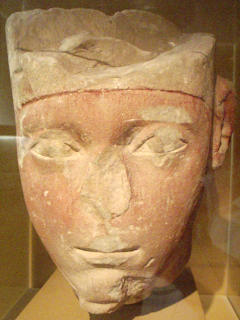"Amenhotep I: The Consolidator of Power and Patron of Culture in Ancient Egypt"
Amenhotep I, also known as Amenophis I, was an ancient Egyptian pharaoh who ruled during the 18th Dynasty of the New Kingdom period. He ascended to the throne around 1526 BCE and reigned for approximately 21 years until his death in 1506 BCE. Despite his relatively short reign, Amenhotep I played a significant role in the history of ancient Egypt.
Amenhotep I was the son of Ahmose I and Queen Ahmose-Nefertari, and he was born in Thebes, the capital city of ancient Egypt. His father, Ahmose I, was a pharaoh who successfully expelled the Hyksos, a foreign power that had ruled over Egypt for several centuries. Amenhotep I grew up in a time of political stability and prosperity, which greatly influenced his reign.
One of Amenhotep I's main accomplishments was the consolidation of the New Kingdom's power. He continued his father's efforts to strengthen Egypt's military and expand its influence. Amenhotep I launched military campaigns in Nubia, a region to the south of Egypt, and successfully extended Egypt's control over this area. This expansion brought valuable resources and trade opportunities to Egypt, further enhancing its wealth and influence.
Amenhotep I also focused on internal affairs, particularly the development of infrastructure and religious institutions. He initiated various construction projects throughout Egypt, including the refurbishment of temples and the construction of new buildings. These efforts aimed to enhance the religious and cultural prestige of Egypt and solidify the pharaoh's divine authority.
Additionally, Amenhotep I played a crucial role in the religious and political transition of ancient Egypt. He was one of the first pharaohs to elevate the god Amun to a position of great importance. Amun became the chief deity of the Theban Triad, a group of three gods worshipped in Thebes, which included Amun, his consort Mut, and their son Khonsu. This elevation of Amun's status contributed to the growing influence of the Theban region and its priesthood, which would lead to significant changes in Egyptian religious practices in the future.
Amenhotep I's reign also witnessed advancements in art and culture. The pharaoh actively supported the arts, commissioning various sculptures and reliefs that celebrated his achievements and divine status. These artistic works showcased the artistic talents of the period and helped shape the artistic style of the New Kingdom.
Despite his accomplishments, Amenhotep I faced challenges during his reign. The pharaoh had to deal with occasional rebellions and uprisings in certain regions of Egypt. However, his strong military and administrative policies allowed him to maintain control and suppress these revolts.
Amenhotep I's death in 1506 BCE marked the end of a successful reign. He was buried in a tomb in the Valley of the Kings, an ancient burial ground for pharaohs. His son, Thutmose I, succeeded him to the throne and continued his father's policies, further expanding Egypt's power and influence.
In conclusion, Amenhotep I was an influential pharaoh of ancient Egypt who ruled during the 18th Dynasty. His reign was marked by military successes, infrastructure development, and religious reforms. Amenhotep I played a vital role in consolidating the New Kingdom's power and fostering the growth of Egyptian culture and religion. His reign set the stage for future advancements and achievements in ancient Egypt.

